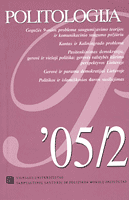Sąjūdis: teorija ir praktikai
Sąjūdis: Theory and Practice
Author(s): Rytis BulotaSubject(s): Politics / Political Sciences
Published by: Vilniaus universiteto leidykla & VU Tarptautinių santykių ir politikos mokslų institutas
Keywords: Lithuanian Reform Sąjūdis Initiative group; history of Sąjūdis as a mass social movement; theory of social movements; political opportunities concept; mobilizing structures concept; cultural formation concept; role of Catholic Church in Lithuania transiti
Summary/Abstract: In this article author reviews the memoirs of the members of the Lithuanian Reform Sąjūdis Initiative group on the events starting from June 3, 1988 up to the restoration of Independence on March 11, 1990. The events are used to illustrate the theoretical analysis of the history of Sąjūdis as a mass social movement. In this paper the given historical period is analyzed on the basis of theoretical models of social sciences. Author does not aim at reconstructing the analyzed historical period. What attracts the author is the memories of the events’ core participants and the way they look from the theoretical point of view. Three theoretical concepts are used widely in the theory of social movements.These are: “the political opportunities”, “mobilizing structures” and “cultural formation”. They include three broad groups of factors. The first one has to deal with the structure of political opportunities and constraints the movement faces; the second contains the forms of formal and informal organization accessible to the movements’ participants and supporters; and the processes of collective interpretation, attachment and construction, mediating in between the political opportunity and the social action, is the third one. The paper is divided into the following parts. In the first part the author ponders on the political opportunities as well as presents the genesis of Sąjūdis.The concept of the political opportunity seems to be the most important for theanalysis of the social movements. It provides the basis for the genesis of the social movement. Moreover, it faces a constant dynamic development of its own, the fact that is evident in Sąjūdis history. In the second he analyses the phenomenon of the cultural formation in relation to the mobilization potential of Sąjūdis. The third part is devoted to the analysis of the mobilization structures and thedevelopment of political opportunities. The final chapter is dedicated to the other political forces and their influence over the Sąjūdis’ development. At the end the author concludes that once Sąjūdis had implemented its principal objectives, it suffered the destiny the majority of mass movements did – the glue that allowed one to bind the completely different people together, and the supporters of the movement chose to move their ways.
Journal: Politologija
- Issue Year: 2003
- Issue No: 3 (31)
- Page Range: 21-37
- Page Count: 17
- Language: Lithuanian

